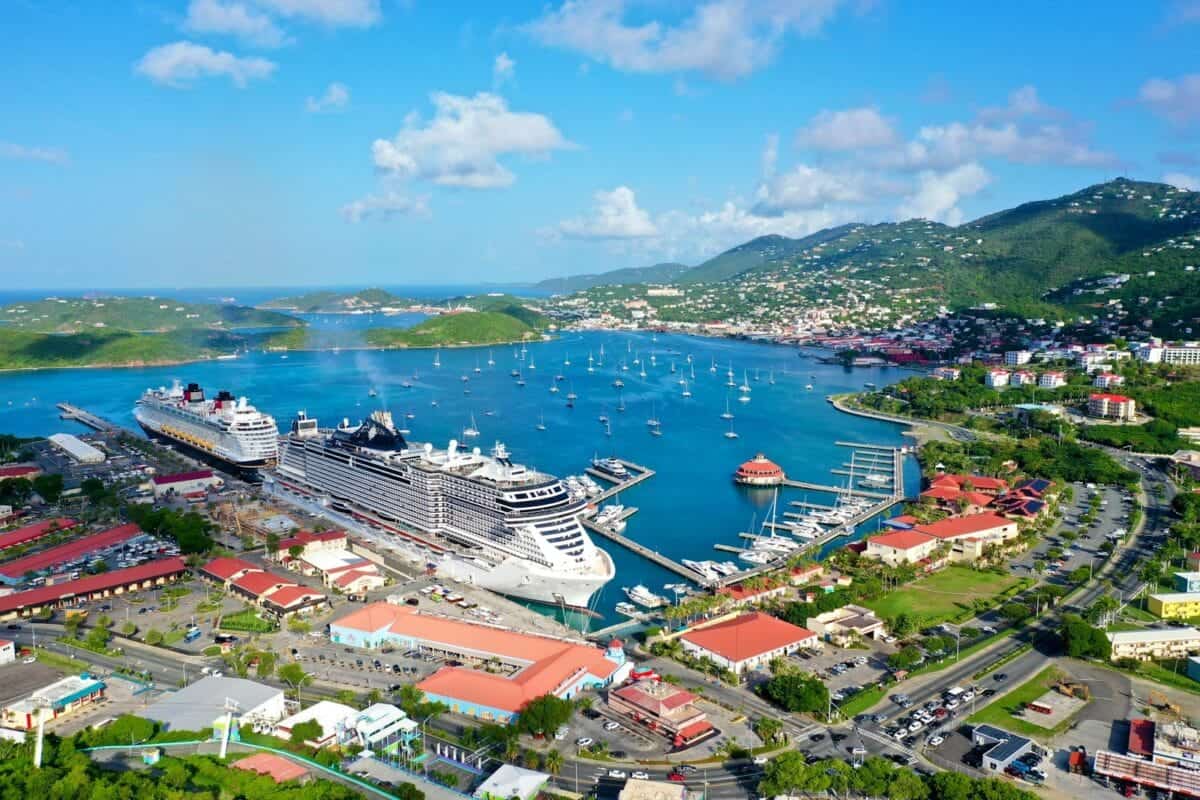US Virgin Islands Travel Guide: Caribbean Bliss, History & Island Escapes
Intro to US Virgin Islands Travel Guide
The US Virgin Islands are the Caribbean’s easy-access paradise — where you can snorkel coral gardens, sip rum beneath palm trees, and explore colonial forts without a passport. Comprising three main islands — St. Thomas, St. John, and St. Croix — this unincorporated US territory offers a mix of beach bliss, eco-adventures, Afro-Caribbean culture, and American convenience.
Whether you’re diving shipwrecks in St. Croix, hiking through Virgin Islands National Park on St. John, or shopping duty-free in St. Thomas, the USVI offers something for every traveler.
Start planning with our complete US Virgin Islands Tours — including regional highlights, travel tips, cultural etiquette, costs, and the best things to do on each island.
💡Quick Facts:
Destination: US Virgin Islands
Continent: North America
Country: United States (Territory)
Administrative Divisions: 3 main islands – St. Thomas, St. John, St. Croix; plus smaller surrounding islets
Area: 346.36 km²
Population: ~87,000
Density: Approx. 251 people per km²
Capital: Charlotte Amalie (St. Thomas)
Regions/Subregions: St. Thomas, St. John, St. Croix
Official & Regional Languages: English (official); Spanish and Virgin Islands Creole also spoken
Currency: United States Dollar (USD)
Time Zone(s): Atlantic Standard Time (GMT–4); no daylight saving time
Airports: Cyril E. King Airport (STT), Henry E. Rohlsen Airport (STX)
Climate: Tropical marine; warm and humid year-round, with a rainy season June–November
Known For: Virgin Islands National Park (St. John), white sand beaches, Caribbean festivals, snorkeling, colonial forts
🛂Arrival Info:
– U.S. citizens do not need a passport to enter
– International travelers require a valid U.S. visa or ESTA
– No customs checks for U.S. mainland travel, but ID may be required
– Non-U.S. visitors must comply with standard U.S. immigration policies
– Official entry info: U.S. Customs & Border Protection
– ESTA portal (for visa-free nationalities)
💉Health Info:
– No vaccine requirements for entry
– Routine vaccines (MMR, Hepatitis A & B, Tetanus) recommended
– Dengue and Zika viruses have been present; insect repellent advised
– Hospitals in St. Thomas and St. Croix offer basic emergency care
– Travel insurance with emergency evacuation coverage is recommended
– Health department: USVI Department of Health
✅ Check travel insurance options for travel emergencies, delays, and medical needs abroad — Get coverage here
✅ Stay Informed with Official Updates: WHO – International Travel & Health | CDC – Travel health updates
🚨Travel Advisory:
Generally safe; rated Level 1 – Exercise Normal Precautions
Petty crime possible in Charlotte Amalie and Frederiksted — stay aware in isolated areas
Hurricane season: June to November — monitor forecasts
✅ Stay Informed with Official Updates: US Travel Advisory | UK Foreign Travel Advice
📅Holidays:
– Transfer Day – Mar 31: Marks US purchase from Denmark in 1917
– Virgin Islands Carnival – April (St. Thomas), July (St. John), December (St. Croix)
– Emancipation Day – July 3: Commemorates abolition of slavery in 1848
– US National Holidays also observed (e.g., Independence Day, Thanksgiving)
💰Visitor Info:
– Currency: USD
– ATMs widely available; cards accepted at most hotels, restaurants
– Tipping: 15–20% expected in restaurants and taxis
– Duty-free allowance from the USVI to mainland U.S.: $1,600 per person (higher than most U.S. territories)
Daily Budget:
– Budget: $75–$120
– Midrange: $130–$250
– Luxury: $300+
✈️Airports:
The USVI has two main international airports:
Cyril E. King Airport (STT) – On St. Thomas, the busiest airport.
Direct flights from mainland U.S. and Puerto Rico.
Henry E. Rohlsen Airport (STX) – On St. Croix.
Water-based transport: Inter-island ferries and cruise ship terminals are active year-round.
✅ Delayed or canceled flight? Check if you’re eligible for compensation
🚍Transport:
– Local taxis are common; rates are fixed by destination, not meter
– Public “safari” buses available on St. Thomas and St. Croix
– Rental cars popular, especially for exploring St. Croix and St. Thomas
– Driving is on the left side
– Ferries run between St. Thomas, St. John, and St. Croix
✅ Book reliable airport transfers and in-city rides in advance. Reserve your ride here
📶Connectivity:
– U.S. mobile carriers (AT&T, T-Mobile) operate without roaming for U.S. subscribers
– SIM cards available for tourists; Wi-Fi in most hotels and resorts
– eSIMs (Airalo, aloSIM) work with most networks
– Coverage is strong on main islands, weaker on remote beaches
✅ Stay connected abroad with affordable eSIM data packs. Get your eSIM here
📜Laws & Etiquette:
– Legal drinking age: 18
– Smoking banned in enclosed public spaces
– Swimwear should be worn only at beaches and pools
– LGBTQ+ rights are protected under U.S. law
– Dress modestly in towns; casual beachwear is fine in tourist areas
– Don’t photograph people without permission at local festivals or cultural events
🛡️Emergency Info:
– Emergency: 911
– U.S. Virgin Islands Police Department: +1 340-774-2211
– U.S. citizens can contact their representatives via U.S. Embassy Barbados (covers the Eastern Caribbean)
– Emergency Health: Schneider Regional Medical Center (St. Thomas), Juan F. Luis Hospital (St. Croix)
✅ Use embassy locator tools: Embassies Worldwide
🌦️Weather:
– Warm and sunny year-round, 26–32°C (79–89°F)
– Hurricane season: June to November (especially Sept–Oct)
– Best time to visit: December to April for dry, breezy weather
– Rain showers are brief and tropical
✅ Stay prepared—check the weather forecast for your destination — Weather Forecast
US Virgin Islands by Region – Where to Go
St. Thomas (Gateway & City Life)
- Charlotte Amalie – Historic capital with cobbled streets, colonial forts, and luxury shopping.
- Magens Bay – One of the Caribbean’s most beautiful beaches with calm waters.
- Red Hook – Lively marina town with ferries to St. John, nightlife, and restaurants.
- Drake’s Seat – Lookout point with panoramic views of the bay and islands.
St. John (Nature & Seclusion)
- Virgin Islands National Park – Covers over half the island; home to lush trails and historic ruins.
- Trunk Bay – Famous for its underwater snorkeling trail.
- Cruz Bay – St. John’s main hub with shops, ferry access, and relaxed dining.
- Coral Bay – Laid-back alternative with local charm and fewer crowds.
St. Croix (Culture & Diving)
- Christiansted & Frederiksted – Twin colonial towns with Danish architecture and waterfronts.
- Buck Island Reef National Monument – Premier snorkeling and scuba site.
- Salt River Bay – Bioluminescent bay and kayaking hotspot.
- Cruzan Rum Distillery – Historic rum producer offering tastings and tours.
Smaller Islands & Day Trips
- Water Island – Off St. Thomas, known for Honeymoon Beach and quiet hideaways.
- Hassel Island – Historic ruins and hiking trails near Charlotte Amalie harbor.
- Culebra & Vieques (Puerto Rico) – Optional day trips via ferry or charter from St. Thomas.
Top Places to Visit in the US Virgin Islands
Beaches & Bays
- Magens Bay (St. Thomas) – Calm, scenic, and family-friendly.
- Trunk Bay (St. John) – Known for its iconic snorkeling trail.
- Sandy Point (St. Croix) – A seasonal beach and sea turtle nesting site.
- Honeymoon Beach (Water Island) – Quiet escape with kayak and chair rentals.
Nature & Adventure
- Virgin Islands National Park – 20+ hiking trails, historic sugar plantations, and unspoiled beaches.
- Buck Island Reef (St. Croix) – One of the few underwater national monuments in the US.
- Ram Head Trail (St. John) – Cliffside hike with stunning coastal views.
- Kayaking Bioluminescent Bays (St. Croix) – Glowing nighttime paddle adventures.
History & Culture
- Fort Christian (St. Thomas) – 17th-century red fort and museum in Charlotte Amalie.
- Estate Whim Plantation (St. Croix) – Preserved sugar estate showcasing colonial life.
- St. George Village Botanical Garden – Set on old plantation ruins, with native flora and local art.
- St. Thomas Synagogue – The second oldest synagogue in the Western Hemisphere.
How to Choose Where to Go in the US Virgin Islands
- For first-time visitors & shopping: Base in St. Thomas.
- For couples & nature lovers: Stay in St. John for remote beaches and national parks.
- For culture, history & diving: Explore St. Croix with its towns and marine sites.
- For beach getaways & peace: Visit Water Island or Coral Bay (St. John).
You can island hop easily via ferries, making multi-island trips ideal for 5–10 day stays.
How to Get Around the US Virgin Islands
- Ferries – Regular service between St. Thomas and St. John; less frequent to St. Croix (air preferred).
- Taxis – Shared taxis are common on St. Thomas and St. John; negotiate or confirm fare.
- Rental Cars – Best for exploring St. John and St. Croix independently; drive on the left.
- Safari Trucks – Open-air public transport on St. Thomas (routes marked by signs).
- Domestic Flights – Cape Air, Seaborne, and Silver Airways connect St. Thomas ↔ St. Croix.
Tip: St. John has no airport — fly into St. Thomas and take the ferry.
Travel Budget & Costs in the US Virgin Islands
Average Daily Costs:
- Budget: $80–120/day (guesthouses, local food, public transport)
- Mid-range: $150–250/day (hotels, car rental, excursions)
- Luxury: $300–600+/day (resorts, sailing, fine dining)
Sample Prices:
- Inter-island ferry: ~$7–12 (St. Thomas ↔ St. John)
- Taxi ride (short): ~$5–10/person
- Snorkel tour: $50–100
- Hotel (mid-range): $130–250/night
- Local meal (roti, seafood): $12–20
Ways to save:
- Stay in Airbnbs or local inns
- Eat at food trucks or beach bars
- Use shared taxis and ferry combos
Best Time to Visit the US Virgin Islands
High Season (December–April):
- Best weather, lowest humidity, and lots of events.
- Higher prices, especially during holidays.
Shoulder Season (May–June, November):
- Fewer crowds, lower rates, and pleasant weather.
Hurricane Season (July–October):
- Risk of storms, but great deals on flights and hotels.
- Many restaurants and tours may close or limit hours.
Must-See Experiences in the US Virgin Islands
- Snorkel the underwater trail at Trunk Bay, among coral and fish
- Hike to Ram Head Point for sunrise over the sea
- Tour Cruzan Rum Distillery, sampling small-batch local blends
- Island hop by sailboat, anchoring in hidden coves
- Visit Fort Christiansvaern and walk the colonial lanes of Christiansted
- Watch a steelpan band perform live during sunset happy hour
- Experience Carnival in April (St. Thomas) or July (St. Croix)
- Kayak through a glowing bioluminescent bay at night
Explore curated US Virgin Islands tours and discover the most authentic things to do in USVI across all three main islands.
Best Travel Itineraries in the US Virgin Islands
Classic Island Hop – 7 Days
- St. Thomas → St. John → Water Island
Perfect balance of beaches, city, and quiet.
Adventure & Culture – 8 Days
- St. Croix → Buck Island → Christiansted → Salt River → St. Thomas
For diving, history, and offbeat charm.
Luxury Escape – 5 Days
- St. John villa + St. Thomas yacht charter
Ideal for honeymoons or special occasions.
Family Fun – 6 Days
- St. Thomas → Coral World Ocean Park → St. John hikes + ferry day trips
Easy and educational for all ages.
Local Cuisine & Culinary Experiences
Fijian cuisine is a flavorful blend of Afro-Caribbean, Creole, and American Southern influences.
Must-Try Dishes
- Conch Fritters – Crispy seafood bites served with dipping sauce
- Roti – Indian-style flatbread wrap with curried meat or veggies
- Pates – Fried pastries stuffed with beef, saltfish, or cheese
- Callaloo Soup – Leafy green stew made with okra and meats
- Fungi & Fish – National dish of cornmeal mush and stewed fish
Drinks:
- Bush Tea – Herbal infusion made with native plants
- Painkiller – Rum, pineapple juice, cream of coconut, nutmeg
- Cruzan Rum – Try local flavors like coconut, mango, or dark spiced
Enjoy a rum-tasting, beach barbecue, or seafood night market to experience island flavors.
Travel Safety & Cultural Etiquette in the US Virgin Islands
Safety Overview
- USVI is safe and welcoming to visitors.
- Petty theft can occur — lock valuables, especially on beaches.
- Water currents can be strong — heed beach warnings.
Cultural Etiquette
- Greet locals with “Good morning” or “Good afternoon” — it’s a sign of respect.
- Tipping is expected (15–20%).
- Swimwear is for the beach — cover up in town or shops.
- Respect slow island time; things don’t always run on schedule.
Where to Go Next – Pair the US Virgin Islands with These Destinations
- British Virgin Islands – Just a boat ride away (passport required).
- Puerto Rico – Quick flight or ferry to continue the Caribbean journey.
- St. Martin or Anguilla – More island-hopping with great beaches and food scenes.
- Dominican Republic – Combine remote beaches with bigger resorts and adventure.
- Barbados or Antigua – Longer-haul pairings for multi-island Caribbean trips.
Where to go next – Explore our Vibrant Puerto Rico Vibes, Sail the British Virgin Islands, Anguilla’s Hidden Beaches, St. Martin Island Fusion, Dominican Republic Escapes, Barbados Coastal Bliss, and Antigua’s 365 Beaches to build the perfect Caribbean itinerary.
Final Planning Checklist for the US Virgin Islands
- No passport required for US citizens
- Currency: US Dollar (USD)
- Drive on the left, even though it’s a US territory
- Sunscreen must be reef-safe (oxybenzone- and octinoxate-free)
- Reserve ferries, rental cars, and tours in advance during peak season
- Pack light clothing, sun protection, water shoes, and bug spray
- Island Wi-Fi can be slow — download offline maps ahead
- Bring your National Park pass if visiting other US parks
Explore the US Virgin Islands with confidence using our trusted tips, local insights, and region-by-region planning tools.
For more expert travel tips, practical strategies, and trusted tools — visit our Homepage and get inspired for your next trip.










